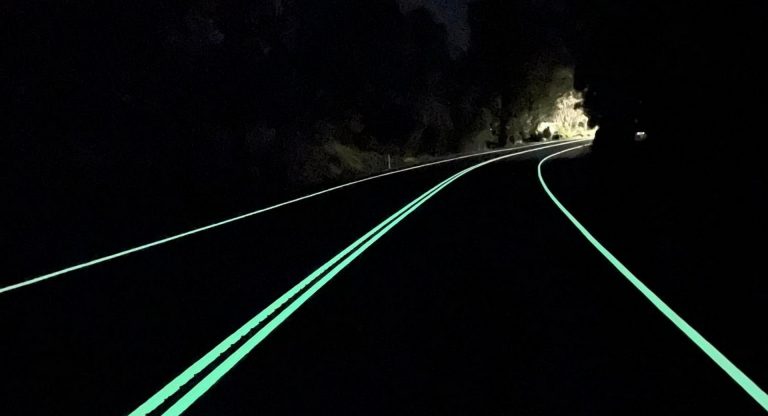
Fluorescent or photoluminescent road markings have been trialed in Australia, particularly by a company called Tarmac Linemarking in Victoria. These markings use a special paint that absorbs light during the day and emits a glow at night, improving visibility on roads, especially in low-light or rural areas without street lighting. The idea is to enhance driver safety by making lane lines and road edges clearer in the dark, potentially reducing accidents.
The technology works similarly to glow-in-the-dark materials, like those in kids’ toys or watch hands, using compounds like strontium aluminate to store and release light. Trials have been conducted on stretches of road in Victoria, such as Metung Road, and have shown promise for applications beyond roads, like bike paths, car parks, and boat ramps. It’s a clever use of passive lighting, which means no electricity is needed, making it eco-friendly and cost-effective compared to installing streetlights.
However, there are challenges. Some critics point out that the glow can weaken on overcast days or in heavy rain, and the paint’s durability is a concern—constant exposure to traffic, weather, and UV light might degrade its effectiveness faster than traditional reflective markings with glass beads. Maintenance could be a headache, and scaling it up for widespread use might not be as practical as it sounds. Plus, there’s the cost—while it’s cheaper than streetlights, it’s still pricier than standard road paint.
Register for Tekedia Mini-MBA edition 19 (Feb 9 – May 2, 2026): big discounts for early bird.
Tekedia AI in Business Masterclass opens registrations.
Join Tekedia Capital Syndicate and co-invest in great global startups.
Register for Tekedia AI Lab: From Technical Design to Deployment (next edition begins Jan 24 2026).
On the flip side, the concept has sparked a lot of excitement because it tackles a real problem: nighttime driving can be dangerous, especially on unfamiliar or poorly lit roads. If they can nail down the durability and consistency, it could be a game-changer. It’s also worth noting that similar ideas have been tested elsewhere, like in the Netherlands, with mixed results, so it’s not entirely new—but Australia’s approach seems to be gaining traction for its practical applications.
Safety, Environmental and Technical Implications
The glowing markings enhance lane and edge visibility in low-light conditions, potentially reducing accidents, especially on rural or unlit roads where crashes are more common at night. For instance, clearer road guidance could help drivers navigate curves or intersections more safely. Applied to bike paths or pedestrian crossings, these markings could make shared spaces safer after dark, addressing urban safety concerns.
The glow’s effectiveness may diminish in heavy rain, fog, or after overcast days when the paint hasn’t absorbed enough light, potentially limiting reliability compared to traditional reflective markings or active lighting. Unlike streetlights, these markings require no electricity, reducing energy consumption and reliance on fossil fuels, aligning with sustainability goals.
The production of photoluminescent compounds (e.g., strontium aluminate) involves mining and chemical processes, which could have environmental impacts if not managed responsibly. Long-term degradation of the paint might also release microplastics or chemicals into the environment. By avoiding artificial lighting, these markings could minimize disruption to nocturnal wildlife and preserve natural nightscapes, a growing concern in eco-conscious regions.
Installing and maintaining streetlights is expensive, especially in remote areas. Fluorescent markings offer a cheaper alternative for improving road safety without ongoing energy costs. The specialized paint is likely pricier than standard road paint, which could strain budgets for widespread adoption, particularly for cash-strapped municipalities.
If the paint wears out faster than conventional markings due to traffic or UV exposure, frequent repainting could offset initial savings, impacting long-term cost-effectiveness. Success here could spur further advancements in smart road technologies, like integrating glow-in-the-dark materials with sensors or self-healing coatings, pushing the boundaries of infrastructure design.
The technology’s effectiveness at scale—across diverse climates, traffic volumes, and road types—remains unproven. Lessons from similar trials e.g., the Netherlands’ failed glow-in-the-dark road project suggest technical hurdles in durability and consistency. These markings could pair well with autonomous vehicle tech, providing visual cues for cameras and sensors in low-light conditions, though they’d need to meet strict standards for machine readability.
Drivers and communities might embrace the novelty and safety benefits, but skepticism about reliability or unfamiliarity could slow acceptance. Education campaigns would be needed to build trust. Road authorities, like those in Australia, have strict standards for markings (e.g., retroreflectivity under headlights). Fluorescent paint must meet or exceed these to gain approval, which could delay rollout.
If adopted primarily in wealthier areas due to costs, it could exacerbate disparities in road safety between urban and rural or affluent and low-income regions. This innovation reflects a global push for safer, smarter infrastructure amid rising road fatalities—Australia alone sees about 1,200 road deaths annually, many at night. It also ties into trends like sustainable urban planning and passive technologies. However, competing solutions, like solar-powered LED road studs or advanced reflective paints, might challenge its niche.



